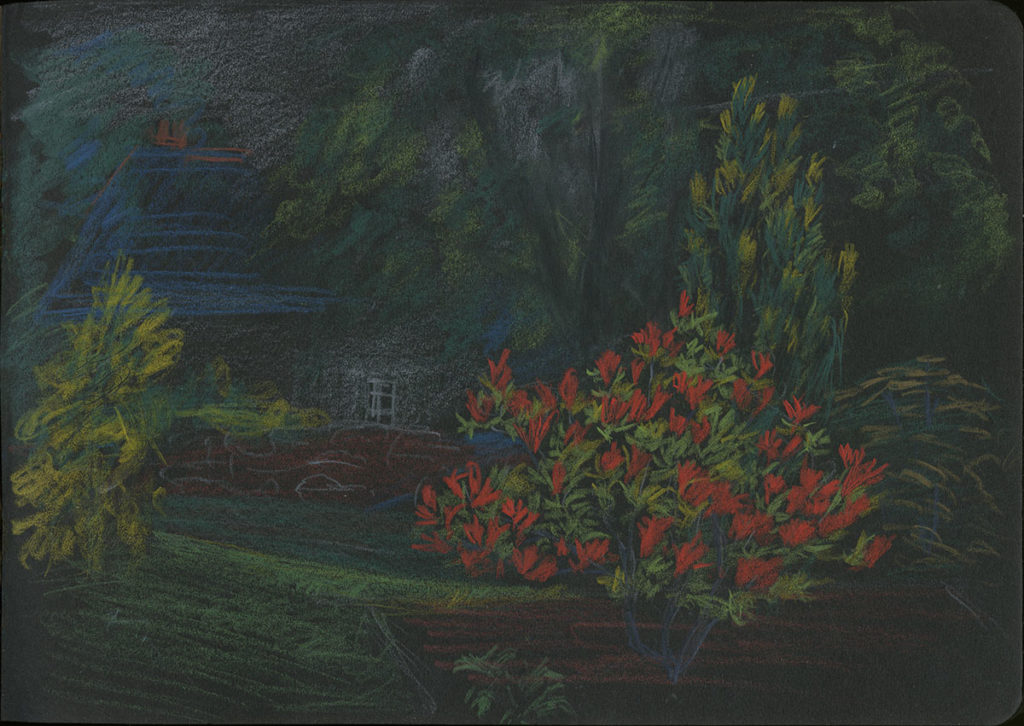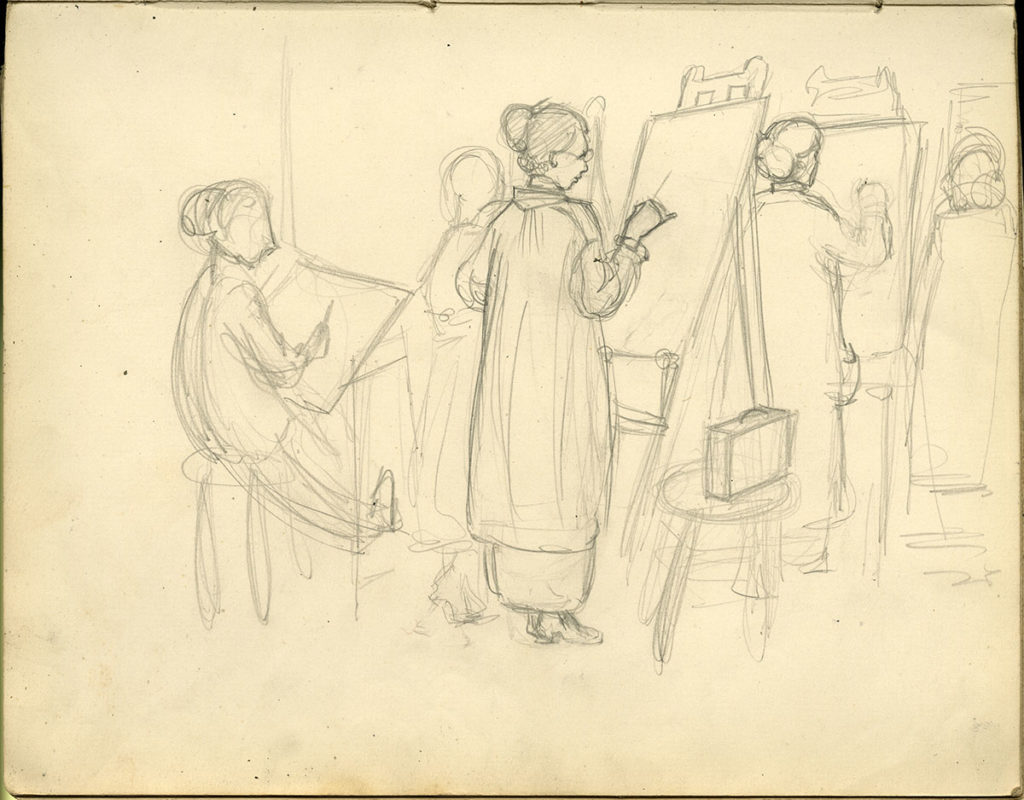In this blog post, SGSAH PhD intern, Molly McCracken shares works created by former student Mary Anderson Ramsay, which have recently been added to the Archives and Collections Catalogue (DC 110).
Ramsay’s deposited collection features a range of sketchbooks and loose artworks produced during her studies at GSA from 1914-1923. These works include architectural drawings, life studies, and children’s illustrations. Together, they showcase the diverse curriculum on offer at The GSA in this period, alongside Ramsay’s developing skills as an artist and designer. The collection captures training that prepared her for later success as the owner and designer of pottery workshop, The Studio.

Mary A. Ramsay was born in 1896 in Partick, the youngest of three children with two elder brothers, William and George. In her early years, the family moved around somewhat frequently. By 1901 her family had moved to Staffa Lodge in Bridge of Allan. Her father worked there as a hygienic physician in the family’s own sanatorium, Salem, established the following year in 1902. This, however, was a relatively short-lived enterprise, as by 1909 Salem was registered under a new name, and in 1911 Mary was living with her parents in Logie, near Stirling, while her brothers had moved out.
At the age of fourteen, Ramsay is registered as a part time school student, suggesting she may have been working alongside her studies to prepare for her eventual enrolment at the GSA. The years from 1911 and until Ramsay commenced her Diploma course provide little clear record for her family being in Scotland. When she registered for her first classes in Design in the 1914-1915 session, she listed a London address (Edith Grove, Chelsea) as her residence, alongside a studio space in Glasgow at 488 Cathedral Street. It’s at this studio that we see an early encounter between Ramsay and artists Margaret Macdonald and Jessie Dunlop McCulloch Wilson, the two GSA students with whom Ramsay would eventually establish their collective pottery enterprise, The Studio.
Registered as a Diploma student at the GSA between 1914-1919, Ramsay’s studies coincided with the entirety of the First World War, a period in which the School experienced significant changes due to the conscription of numerous staff and students, and increasing financial pressures. Mary’s brothers were both conscientious objectors and were imprisoned for their beliefs. Though her surviving artworks make little overt reference to the turbulence of this period, she regularly visited her siblings during this time. One of the brothers, George, was able to secure his release quickly due to powerful social connections. William, the eldest, however, remained incarcerated for the duration of the war; Mary travelled to England to visit him on various occasions throughout her studies.
As a student, Ramsay took a variety of classes, but excelled in her work in Design. In 1918 she not only received her Diploma in Design and Decorative Art, but was also awarded one of four Maintenance Scholarships of £50 (worth approx. £2300 in 2023 when adjusted for inflation) and Professor Anning Bell’s Prize in the Design Department. In the following session she earned an Endorsement on her Diploma for post-graduate study, and over the next few years she continued to take part time courses at The GSA in Design (1920-21), Modelling (1921-22), and Pottery (1922-23), suggesting her increasing interest in the ceramic arts that would soon be the focus of The Studio.
From 1923 Ramsay moved with her brother William to Perthshire, where she would in 1926 take tenancy of The Studio in Strathyre. Perhaps inspired by the increasing prominence of women artists at The GSA during the wartime years, The Studio was a collaborative endeavour between Ramsay, Macdonald, and Wilson. The women would buy in pottery blanks from industrial potteries and hand paint them with a range of floral designs before selling them to consumers. Surviving artworks from The Studio are held by a number of private owners and public collections in Stirling and Perthshire, as well as the Scottish Pottery Society.

The scene of women sharing working space together points towards her later collaborative work in The Studio.
Ramsay’s works from this time have been compared to other distinguished female GSA alumni, such as Jessie M King and Annie French, and suggest the further influence of the Glasgow Style with its use of linear, elongated patterns. Over time, however, the designs shifted towards a bolder and more painterly style departing from the earlier traditions, and targeted towards the increasing consumer market for attractive homewares.
The newly catalogued works by Mary Ramsay, held within GSA Archives and Collections span the duration of her studies and chart the development of Mary’s technical skills as an illustrator and designer. In her sketchbooks we see her reproductions of ceramic glazes and paintings, as well as her growing interest in floral patterns. These motifs would eventually intersect with the ceramic designs she became famous for at The Studio.
Her loose artworks showcase her talent for drawing, with over thirty detailed portraits and life drawings forming the majority of the collection. Interspersed within her portfolio are other works suggesting her wide-ranging influences: whether literature, seen for example in her illustration of a William Blake poem, or religion, as seen in her altarpiece designs.
Ramsay’s artwork suggests her creative flair and sense of humour: an architectural study features the cartoonish characters seen in her other illustrations, a Little Willie poem is featured alongside transcribed lists of library books, and numerous sketches of cats gesture towards what would eventually become her signature maker’s mark on her pottery.
The collection of Mary Ramsay’s sketchbooks and loose art work, alongside a sample of images of her work, are available to view on The GSA Archive and Collection’s catalogue here.
Sources:
Dickson, Kay. “Strathyre Studio”. Scottish Pottery Historical Review, vol. 13
Jack, Heather. “Strathyre Revisited”. Scottish Pottery Historical Review, vol. 27

